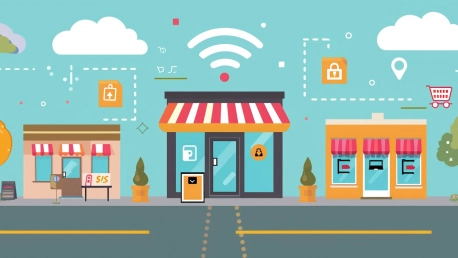The retail industry is on the cusp of a transformative era, with ambient Internet of Things (IoT) technology playing a central role in redefining everyday operations. This shift, embracing real-time data acquisition and supply chain visibility, heralds a new dawn for retailers willing to invest in this digital leap forward. As we delve into the various facets of ambient IoT, it is clear that its impact on retail is profound and far-reaching, promising a future where data and efficiency drive the market.
Emerging Challenges and the IoT Response
Current Retail Landscape and the Urgency for Transformation
The retail sector faces a tidal wave of challenges, driven by powerhouse companies that have built empires on the pillars of data and technological prowess. Retail giants like Amazon and Walmart exemplify how technology can streamline operations and elevate the customer experience. This has, by default, raised the bar for all players in the market, making technological adaptation not a choice but a necessity. The burgeoning direct-to-consumer models, buoyed by tech advancements, only add to the urgency, as they bypass traditional retail channels, creating a more competitive landscape.
Overcoming Skepticism: The Case for Ambient IoT Adoption
Despite clear signals that the retail environment is rapidly changing, skepticism towards new technologies persists. The perception of high costs and complex integration processes has made many retailers cautious. However, these concerns are increasingly being outweighed by the demonstrable benefits that ambient IoT offers. It is paramount for retailers to scrutinize the real versus perceived risks of early adoption, as the cost-benefit analysis often reveals the fallacy that new tech investments are fraught with risk.
Ambient IoT: A Technological Leap Forward
Beyond RFID: The Advent of IoT Pixels
Groundbreaking innovations in IoT have catapulted beyond the capabilities of traditional RFID technology. IoT pixels, minuscule and self-sustaining sensors, offer functionalities like precise location tracking and environmental condition monitoring. These pixels do not require extensive installation efforts or large-scale scanning equipment. Consequently, they embody the seamless integration potential of ambient IoT, marking a significant step forward in the way retailers can manage their operations and gather actionable data.
The Data-Driven Paradigm in Retail
The data-driven paradigm has become a staple in modern retail strategy. Data isn’t just king – it’s the entire kingdom, enabling retailers to create exceptional customer experiences that were once unimaginable. Technology has transitioned from being an optional accessory to a fundamental component of retail achievement. The seamless interconnection of ambient IoT devices feeds this new paradigm, supplying retailers with the information necessary to make swift, informed decisions that resonate with efficiency and customer satisfaction.
Realizing the Ambient IoT Advantage
Case Studies: Early Adopters Leading the Way
The benefits of ambient IoT are not hypothetical; they are evident in the achievements of early adopters. A major pharmacy chain, for instance, has harnessed ambient IoT to refine inventory management and enhance consumer safety dramatically. An apparel retailer has utilized these same innovations to gain precise control over stock levels, resulting in fewer stockouts and an optimized bottom line.
Operational Benefits & Competitive Edge
By wielding ambient IoT, retailers pinpoint inventory discrepancies in real-time, reducing stockouts and ensuring products are always available for consumers. The advantages reach beyond inventory control; food retailers have seen notable improvements in complying with safety regulations via constant monitoring of environmental conditions. This not only secures consumer trust but also builds a competitive edge that is hard to replicate without similar technological integration.
Ambient IoT as a Catalyst for Efficiency and Sustainability
Driving Efficiencies Across the Supply Chain
Real-time visibility into inventory levels and logistics is revolutionizing the supply chain. Ambient IoT empowers retailers with insights that drive informed decisions, streamline operations, and reduce resource waste. These efficiencies are rippling through the entire retail ecosystem, presenting new opportunities for cost savings and enhanced service delivery.
Fostering Sustainability Through Technology
Retailers are finding that ambient IoT aligns with broader sustainability goals. Monitoring and optimizing delivery routes reduces carbon footprints, while smarter inventory management leads to less waste. The dual benefits of operational efficiency and environmental responsibility position IoT at the forefront of sustainable retail practices.
Strategies for Embracing Ambient IoT in Retail
From Hesitation to Action: Encouraging the Shift
It is imperative for retailers to cross the chasm from hesitant observers to active participants in the realm of ambient IoT. Building confidence through education and demonstrating clear returns on investment are critical in stimulating this migration. Guideposts for beginning the IoT journey are emerging, aimed at navigating the initial complexities and fostering a mindset attuned to the value of technology.
Constructing a Future-Proof Retail Business
The retail landscape is on the edge of a significant transformation, with the Internet of Things (IoT) at the forefront of changing how businesses operate. With the advent of ambient IoT, retailers can now leverage real-time data on a scale like never before, enabling unprecedented levels of supply chain transparency and operational efficiency.This shift towards a more digitally integrated retail environment means that companies ready to make the jump into this new era stand to gain a competitive edge. Ambient IoT technology isn’t just a buzzword; it’s the backbone of a data-driven approach that can unlock improvements in customer service, inventory management, and the overall shopping experience.Stores equipped with IoT devices can track inventory with greater accuracy, predict trends, and streamline logistics. Customer interactions also improve, as data collected through IoT can personalize the shopping experience, leading to higher satisfaction and loyalty.Furthermore, the connectivity allows for better energy management, theft prevention, and maintenance operations, cutting costs and enhancing safety measures. As we embrace this smart retail future, it’s evident that IoT tech is redefining the potential of retail, guiding it towards a more informed, efficient, and customer-centric approach. Early adopters of this technology will likely lead the pack as the retail industry continues to innovate and evolve with the digital age.









